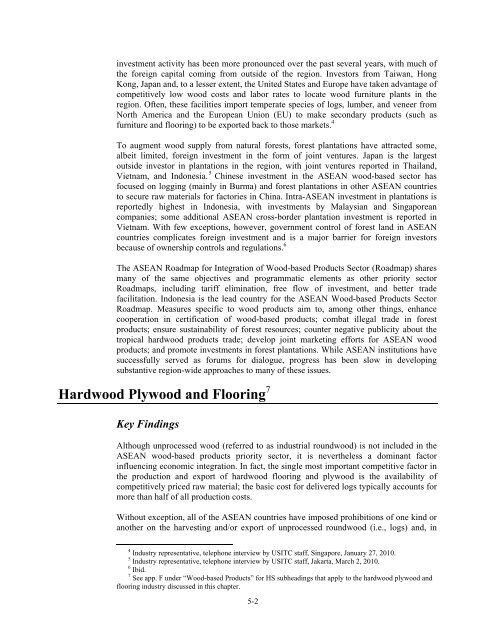ASEAN: Regional Trends in Economic Integration, Export ... - USITC
ASEAN: Regional Trends in Economic Integration, Export ... - USITC
ASEAN: Regional Trends in Economic Integration, Export ... - USITC
You also want an ePaper? Increase the reach of your titles
YUMPU automatically turns print PDFs into web optimized ePapers that Google loves.
<strong>in</strong>vestment activity has been more pronounced over the past several years, with much of<br />
the foreign capital com<strong>in</strong>g from outside of the region. Investors from Taiwan, Hong<br />
Kong, Japan and, to a lesser extent, the United States and Europe have taken advantage of<br />
competitively low wood costs and labor rates to locate wood furniture plants <strong>in</strong> the<br />
region. Often, these facilities import temperate species of logs, lumber, and veneer from<br />
North America and the European Union (EU) to make secondary products (such as<br />
furniture and floor<strong>in</strong>g) to be exported back to those markets. 4<br />
To augment wood supply from natural forests, forest plantations have attracted some,<br />
albeit limited, foreign <strong>in</strong>vestment <strong>in</strong> the form of jo<strong>in</strong>t ventures. Japan is the largest<br />
outside <strong>in</strong>vestor <strong>in</strong> plantations <strong>in</strong> the region, with jo<strong>in</strong>t ventures reported <strong>in</strong> Thailand,<br />
Vietnam, and Indonesia. 5 Ch<strong>in</strong>ese <strong>in</strong>vestment <strong>in</strong> the <strong>ASEAN</strong> wood-based sector has<br />
focused on logg<strong>in</strong>g (ma<strong>in</strong>ly <strong>in</strong> Burma) and forest plantations <strong>in</strong> other <strong>ASEAN</strong> countries<br />
to secure raw materials for factories <strong>in</strong> Ch<strong>in</strong>a. Intra-<strong>ASEAN</strong> <strong>in</strong>vestment <strong>in</strong> plantations is<br />
reportedly highest <strong>in</strong> Indonesia, with <strong>in</strong>vestments by Malaysian and S<strong>in</strong>gaporean<br />
companies; some additional <strong>ASEAN</strong> cross-border plantation <strong>in</strong>vestment is reported <strong>in</strong><br />
Vietnam. With few exceptions, however, government control of forest land <strong>in</strong> <strong>ASEAN</strong><br />
countries complicates foreign <strong>in</strong>vestment and is a major barrier for foreign <strong>in</strong>vestors<br />
because of ownership controls and regulations. 6<br />
The <strong>ASEAN</strong> Roadmap for <strong>Integration</strong> of Wood-based Products Sector (Roadmap) shares<br />
many of the same objectives and programmatic elements as other priority sector<br />
Roadmaps, <strong>in</strong>clud<strong>in</strong>g tariff elim<strong>in</strong>ation, free flow of <strong>in</strong>vestment, and better trade<br />
facilitation. Indonesia is the lead country for the <strong>ASEAN</strong> Wood-based Products Sector<br />
Roadmap. Measures specific to wood products aim to, among other th<strong>in</strong>gs, enhance<br />
cooperation <strong>in</strong> certification of wood-based products; combat illegal trade <strong>in</strong> forest<br />
products; ensure susta<strong>in</strong>ability of forest resources; counter negative publicity about the<br />
tropical hardwood products trade; develop jo<strong>in</strong>t market<strong>in</strong>g efforts for <strong>ASEAN</strong> wood<br />
products; and promote <strong>in</strong>vestments <strong>in</strong> forest plantations. While <strong>ASEAN</strong> <strong>in</strong>stitutions have<br />
successfully served as forums for dialogue, progress has been slow <strong>in</strong> develop<strong>in</strong>g<br />
substantive region-wide approaches to many of these issues.<br />
Hardwood Plywood and Floor<strong>in</strong>g 7<br />
Key F<strong>in</strong>d<strong>in</strong>gs<br />
Although unprocessed wood (referred to as <strong>in</strong>dustrial roundwood) is not <strong>in</strong>cluded <strong>in</strong> the<br />
<strong>ASEAN</strong> wood-based products priority sector, it is nevertheless a dom<strong>in</strong>ant factor<br />
<strong>in</strong>fluenc<strong>in</strong>g economic <strong>in</strong>tegration. In fact, the s<strong>in</strong>gle most important competitive factor <strong>in</strong><br />
the production and export of hardwood floor<strong>in</strong>g and plywood is the availability of<br />
competitively priced raw material; the basic cost for delivered logs typically accounts for<br />
more than half of all production costs.<br />
Without exception, all of the <strong>ASEAN</strong> countries have imposed prohibitions of one k<strong>in</strong>d or<br />
another on the harvest<strong>in</strong>g and/or export of unprocessed roundwood (i.e., logs) and, <strong>in</strong><br />
4 Industry representative, telephone <strong>in</strong>terview by <strong>USITC</strong> staff, S<strong>in</strong>gapore, January 27, 2010.<br />
5 Industry representative, telephone <strong>in</strong>terview by <strong>USITC</strong> staff, Jakarta, March 2, 2010.<br />
6 Ibid.<br />
7 See app. F under “Wood-based Products” for HS subhead<strong>in</strong>gs that apply to the hardwood plywood and<br />
floor<strong>in</strong>g <strong>in</strong>dustry discussed <strong>in</strong> this chapter.<br />
5-2

















